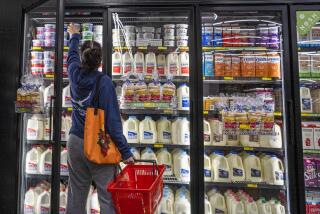Retail Prices Rise Modest 0.2% in August
- Share via
WASHINGTON — Falling grocery and fuel costs held the overall rise in August retail prices to a modest 0.2% for the fourth straight month, the government reported today.
In Los Angeles and Orange counties, consumer prices rose 0.8% last month, led by advances in housing costs, the Labor Department said.
The small rise in the department’s national consumer price index pointed to the prospect of 1985’s cost-of-living increase coming in at the lowest figure in nearly two decades.
Inflation for the first eight months of this year was 3.3% on an annual basis. If the year ends with the same low rate, 1985 will be the best year for inflation since 1967, when the rate was 3%.
Well Below 1984
Virtually all economists see this year’s inflation rate being well below 1984’s 4%. Prices increased 3.8% in 1983 and 3.9% the previous year.
Meanwhile, in a sign that the economy picked up some steam last month, the Commerce Department reported today that orders for “big ticket” durable goods--those expected to last three years or more--rose a healthy 3.4% last month. Discounting military orders, orders for civilian goods rose 2.5%, the biggest gain since February.
Prices for food bought at grocery stores fell 0.1% last month, but were more than offset by increases for foods and beverages consumed away from home, so that the overall food and beverage price component rose 0.1% for the third straight month.
Restaurant Prices Up
Restaurant food prices were up 0.3% while alcohol prices rose 0.6%.
At the grocery store, declines were recorded for fruits and vegetables, meats, poultry, fish, eggs and dairy products.
Energy costs fell across the board. Gasoline prices were down 0.8%, natural gas costs were off 1.1% and fuel oil prices fell 0.7%.
Housing costs rose 0.5%, after increases of 0.3% in both June and July, and included a 0.7% hike for homeowners and a 0.6% rise for renters.
Overall transportation costs, which include gasoline prices, were down 0.4%, largely because of a 1.2% decline in used car prices and a 2.5% drop in auto financing charges--a reflection of industrywide dealer and manufacturer buyer incentives. New car prices, however, rose 0.4%.
Medical care costs, continuing to show the biggest increase of the seven major components of the overall index, rose 0.6%.
More to Read
Inside the business of entertainment
The Wide Shot brings you news, analysis and insights on everything from streaming wars to production — and what it all means for the future.
You may occasionally receive promotional content from the Los Angeles Times.









